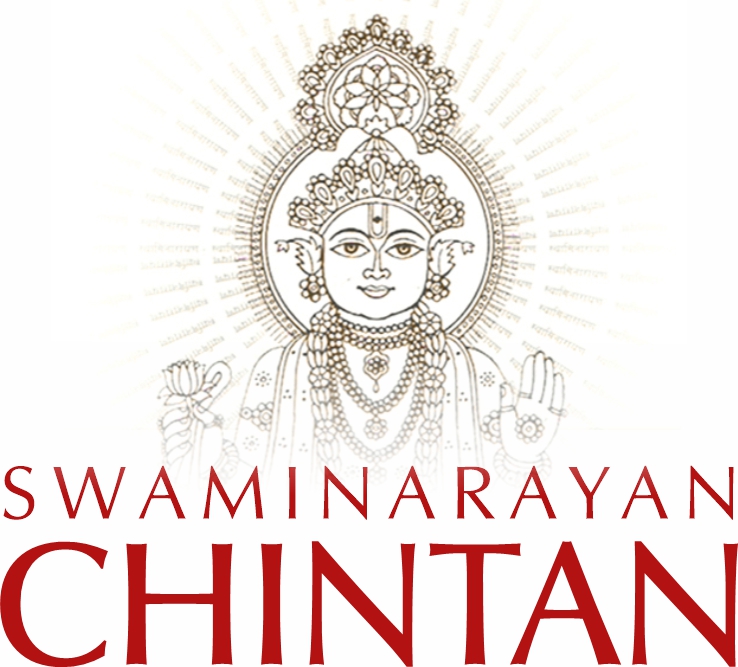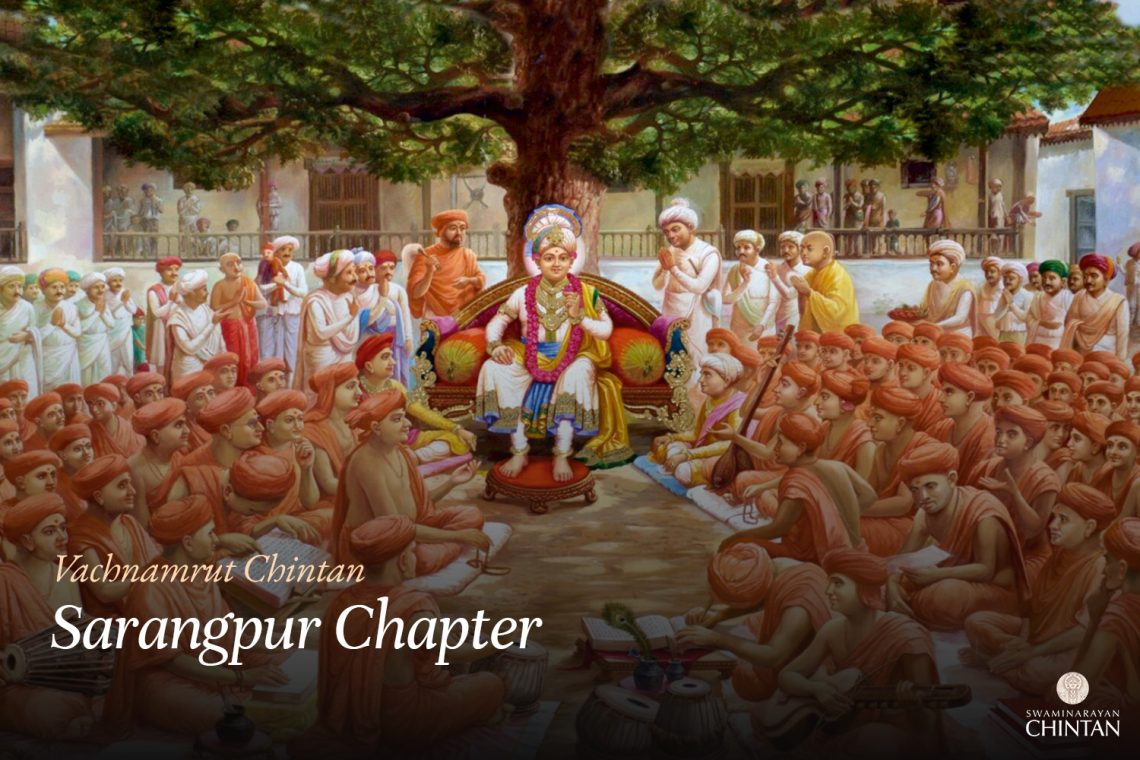Central Insights:
- What is superior, direct worship or mental worship? Characteristics of Shravan, Manan, Nididhyas, and Sakshatkar.
Main Points:
- Worship performed with intense love that causes goosebumps and a choked voice is considered the best.
- If one has extreme faith in Puja and Seva, Katha, and Kirtan, then it is a sign of love and immersion in God.
- Listening to Katha from a virtuous and devoted speaker is called Shravan.
- After Shravan, accepting what is appropriate and discarding what is unnecessary is called Manan.
- Constantly recalling and practicing the thoughts adopted in Manan is called Nididhyas.
- Remembering the matter instinctively without deliberate thinking is called Sakshatkar.
Commentary:
In this Vachanamrut, Swayamprakashanand Swami asked Shreeji Maharaj, “Maharaj, one devotee performs direct worship of God with various physical materials, and another performs mental worship with imagined materials. Who is superior among the two?”
Shreeji Maharaj replied, “If someone worships God with intense love to the point of goosebumps and a choked voice, whether it is direct or mental worship, both are best. However, if the worship is performed without such love and is merely dry, both forms are inferior. Worship, whether direct or mental, should be performed with love. The main aspect is the love and affection towards God. Without love, the worship becomes mere show and loses its value. Hence, Shreeji Maharaj said, whether one performs direct worship or mental worship with intense love, both are best; without it, both are inferior.”
Somala Khachar then asked, “What are the characteristics by which we can identify a devotee who worships Bhagwan with such intense love and thrilled emotions either in person or mentally?”
Shreeji Maharaj replied, “One who has extreme faith in Puja and Seva, Katha, and Kirtan, and understands the immense glory of Bhagwan, such a devotee’s love and faith remain ever fresh and never diminish. For example, Muktanand Swami’s faith and understanding of my glory were the same when I first saw him in Loj and have not diminished to this day. Such characteristics indicate a true devotee.”
Love for God is an internal matter. How do we measure it externally? The nature of love is attachment. This attachment is deeply rooted in the heart. It does not manifest directly in its form but is expressed through specific signs, actions, or behaviors. Shreeji Maharaj explained that if someone has intense love and immersion in God, this will be evident in their devotion to Puja and Seva, Katha, and Kirtan. They will not tire or get bored. If one tires or gets bored in Seva, it indicates a lack of faith and understanding of God’s glory. The enthusiasm and enjoyment in these activities, if they remain constant over time, indicate true love. This is not due to habit or routine but is driven by genuine affection and thus bears fruit.
Many times, devotees exhibit great enthusiasm initially, but like the tide, it wanes quickly. This is not true love from the heart. Often, the actions mentioned above may be done out of artificiality, pretense, or show, but they do not last long. Only those actions that come from a true heart endure for a long time. Others find excuses and fall back after a short while. Hence, Maharaj states that such love and immersion in God should be present. As a result, these actions remain ever-fresh and never diminish. No matter how long they are performed, they do not become tiresome but rather increase in interest and enjoyment. The initial enthusiasm and glory found in temple cleaning should not decrease with time. The novelty in listening to Katha should remain undiminished even today. This indicates that these actions are driven by love and not by routine or rigidity, making them truly fruitful. Maharaj says that the Yadavas lived with God and served Him, but they were not called devotees, whereas Uddhavji is considered a true devotee.
Then Nirvikaranand Swami asked, “Maharaj, please explain to us what Shravan (listening), Manan (contemplation), Nididhyas (constant meditation), and Sakshatkar (realization) are.”
Shreeji Maharaj replied, “Listening attentively to Katha in a peaceful and undisturbed environment with a focused mind is called Shravan. It should be heard from a devotee of Bhagwan, not from someone who is opposed to Bhagwan. The Shravan mentioned here is not just ordinary listening; it is meant to lead to the realization of Atma (Soul) and Paramatma (Subprime being), that is, Maharaj. The Shruti also says,
आत्मा वा अरे दृष्टव्यः श्रोतव्यः मन्तव्यो निदिध्यासितव्यः साक्षात्कर्तव्यश्च
ātmā vā are draṣṭavyaḥ śrotavyo mantavyaḥ nididhyāsitavyaḥ
sākṣātkartavyaś ca
The Atma and Paramatma should be seen, heard about, contemplated upon, meditated upon, and realized. Shravan is a primary means for the realization of Atma and Paramatma. In Shrimad Bhagwat, Shravan Bhakti is proven as the main means for the upliftment of the soul. The best examples of this are Parikshit and Dhundhukari. In Harililamrut, Shravan Bhakti is also considered the highest and foremost among the nine forms of Bhakti. This Shravan is not to be done casually like listening to other things.
Maharaj then said, “After listening to the discourse (Shravan), contemplating on it and discerning which parts are appropriate to retain and which are to be discarded is called Manan. Just as when a person eats food, the solid food is ingested into the stomach where it undergoes a process to become a digestible essence, so too must the solid parts be softened and transformed into a nourishing essence. If any part cannot be transformed into this essence, it is expelled through the excretory system.
Similarly, from Shravan, the meanings captured in the mind are repeatedly contemplated, creating a vital essence necessary for spiritual life. This essence, formed through constant contemplation, becomes decisive and firm. Manan is the process of deciding what to adopt into one’s life and what to discard, making it an integral part of one’s being. This is the task of Manan after Shravan.
Maharaj further explained that Nididhyas is the practice of continuously recalling and meditating on the conclusions reached through Manan, day and night. This practice ensures that the definitive form given by Manan is deeply engraved on the canvas of the mind. By repeatedly revisiting these conclusions, deep impressions are formed, bringing them to the forefront of consciousness. Without effort, these impressions become the nature of one’s thoughts, making Nididhyas a constant presence in all activities. Nididhyas is the process of aligning all actions with a meditative focus. When this is achieved, it is called Nididhyas.”
Maharaj then said, “When one recalls the discourse or concept exactly as it is, without deliberate contemplation, it is called Sakshatkar (realization).”
In this context, Shravan is listening attentively and carefully, while Manan is the decisive contemplation. Manan gives a definitive shape to what is heard through Shravan, and Nididhyas is the state of continuous meditation. When something is remembered for a limited time, it is called Dhyana (meditation), but when it is remembered constantly at every moment, it is called Nididhyas. The subtle difference between Dhyana and Nididhyas is that Dhyana is temporary, while Nididhyas is perpetual. Sakshatkar is the state of uninterrupted, continuous memory, like a steady stream of oil. Hence, Maharaj says that recalling something without deliberate contemplation, as vividly as if it is before one’s eyes, signifies uninterrupted memory.
Thus, Shravan, Manan, Nididhyas, and Sakshatkar form a sequential process for realizing Paramatma (the Supreme being).
Just as in the Gita, Karmayoga (the yoga of action) is considered the supreme means to attain God, which is an action-oriented path, Shravan, Manan, Nididhyas, and Sakshatkar are considered the means to attain God through Jnanayoga (the yoga of knowledge). This is a knowledge-oriented path. For figures like Shukdevji and the Sanak-adik, these methods are predominant. For Janak and Arjun, the action-oriented Karmayoga is predominant. The Gopis worshipped God directly through love. The ultimate goal of all paths is Paramatma (the Supreme being – God) and devotion to Him. In the Karmayoga-oriented devotion of Janak and Arjun, surrender is predominant. In the knowledge-oriented devotion of Shukdevji and the Sanakadi, the emphasis is on understanding God’s glory. In the devotion of the Gopis, love is predominant. Even in the path of knowledge, devotion is the final step.
It is said:
वेदनं ध्यान विश्रान्तं ध्यानं श्रान्तं ध्रुवा स्मृतिः।
सा च दृष्टित्वमभ्येति दृष्टि भक्तित्वमृच्छति।।
vedanaṁ dhyāna viśrāntaṁ dhyānaṁ śrāntaṁ dhruvā smṛtiḥ |
sā ca dṛṣṭitvamabhyeti dṛṣṭi bhaktitvamṛcchati ||
This means that knowledge, when it matures into Dhyan (meditation), transforms into a state of constant remembrance. This continuous remembrance evolves into a direct vision, which then transforms into supreme devotion. Therefore, the ultimate fruit of this process is Paramatma and His devotion.
Thus, Maharaj explains that if one has performed Shravan, Manan, Nididhyas, and Sakshatkar regarding the nature of the Atma and Paramatma, then realization of the Atma and Bhagwan occurs. However, without Manan and Nididhyas, mere Shravan alone does not lead to realization. Maharaj says that if one has performed Darshan (vision) of the form of Bhagwan but has not engaged in Manan and Nididhyas, then even after performing Darshan for a hundred thousand years, one will not realize the form. Such Darshan is equivalent to just Shravan. Hence, those who have performed Darshan of Bhagwan’s form and then engaged in Manan and Nididhyas will be able to recall that form easily.
Some devotees complain that they try to recall the form of Maharaj but are unable to do so. This is true because they have never engaged in Manan after performing Darshan, and directly trying to recall will not work. Even worldly objects cannot be remembered without Shravan and Manan. How, then, can one remember the divine and transcendental form of Maharaj without Shravan and Manan? Therefore, after performing Darshan of Bhagwan and listening to discourses about Him, if one continuously engages in Manan and Nididhyas, then realization occurs. Otherwise, even with a lifetime of Darshan and Shravan, realization will not occur.
Glossary
| Shravan – Listening |
| Manan – Contemplation |
| Nididhyas – Deep Meditation |
| Sakshatkar – Realization |
| Puja – Worship |
| Seva – Service |
| Katha – Spiritual discourse Listening to stories and teachings about Bhagwan, an integral part of Yagna. |
| Kirtan – Devotional songs Singing praises of Bhagwan, which help focus the senses and mind on Him. |
| Direct Worship – Physical offerings in devotion |
| Mental Worship – Worship in the mind |
| Yadavas – Descendants of the Yadu dynasty The clan associated with Lord Krishna, many of whom failed to recognize His divinity fully. |
| Dhyan – Meditation Deep concentration on Bhagwan’s divine form. |
| Bhakti – Devotion Loving and selfless worship of God. |
| Karmayoga – Yoga of Action |
| Gyanayoga – Yoga of Knowledge |
| Paramatma – Supreme God God, the all-pervading and ultimate reality. |

